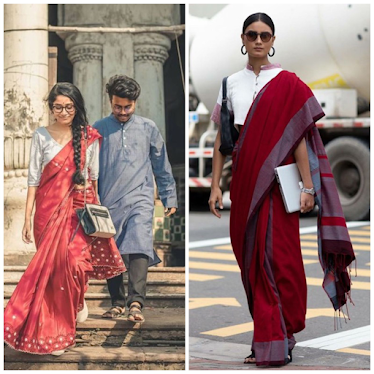The Unfolding Elegance: The Evolving Fashion of Bengali Culture
The Unfolding Elegance: The Evolving Fashion of Bengali Culture
Trinoya
Dhar September 24, 2023 Fashion
and Aesthetics
Bengali culture, steeped in history and tradition, is a
vibrant tapestry of art, literature, music, and of course, fashion. Over the
centuries, the fashion sensibilities of Bengalis have evolved, reflecting
changes in society, politics, and global influences. In this blog, we will
embark on a journey through the ever-evolving world of Bengali fashion,
exploring its historical roots, modern manifestations, and the fusion of
tradition and innovation.
Historical Echoes in Modern Attire
The history of Bengali fashion dates back to ancient
times when the region was influenced by various dynasties and cultures. The
Mughal and Persian influence during the medieval period left a profound impact
on clothing. Elements like the 'jama' for men and the intricate 'jamdani'
sarees for women found their way into Bengali attire.
However, it was during the British colonial era that the
fusion of Western and Bengali fashion truly began. The British introduced
clothing like shirts, trousers, and blouses, which gradually became a part of
everyday attire. This influence can still be seen today in the way Bengalis
incorporate Western elements into their traditional clothing.
The Quintessential Bengali Saree
One cannot discuss Bengali
fashion without mentioning the iconic Bengali saree. The saree is an integral
part of Bengali culture, and it has adapted to changing times while retaining
its essence. The traditional red and white saree worn by Bengali brides remains
a symbol of purity and tradition, but modern variations now include a plethora
of colors and designs.
Innovative saree draping styles have also emerged, offering a contemporary twist to this timeless attire. Young Bengali women are experimenting with unique drapes, accessorizing with belts, jackets, and statement jewelry, showcasing the versatility of the saree.
The Revival of Handloom
In recent years, there has been a revival of interest in
traditional handloom fabrics. Tant sarees, known for their comfort and
simplicity, are experiencing a resurgence in popularity. These sarees are woven
by skilled artisans and are cherished for their intricate motifs and delicate
craftsmanship.
Many designers are also collaborating with weavers to create modern interpretations of traditional handloom fabrics, blending age-old techniques with contemporary fashion aesthetics. This movement not only preserves cultural heritage but also supports the livelihoods of local artisans.
Sustainable and Ethical Fashion
Bengali fashion enthusiasts are increasingly mindful of
sustainability and ethical practices. This has led to a surge in demand for
eco-friendly fabrics, locally sourced materials, and responsible fashion
choices. Designers are embracing these principles and incorporating them into
their collections.
The evolving fashion of Bengali culture beautifully reflects the adaptability and resilience of this vibrant community. It harmoniously blends the rich traditions of the past with the demands of the present, all while embracing sustainability and ethical considerations. As Bengali fashion continues to evolve, it serves as a testament to the enduring beauty of cultural heritage and the creativity of those who shape its future. In a world that is constantly changing, Bengali fashion remains a symbol of identity and a source of pride for the Bengali people.







Comments
Post a Comment